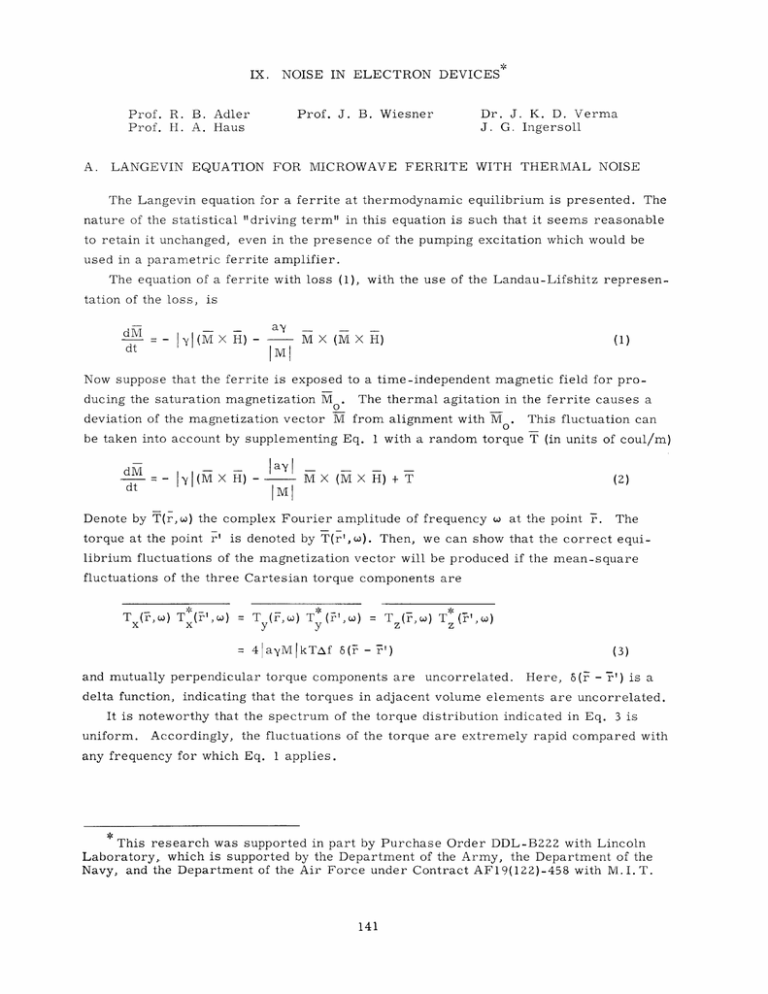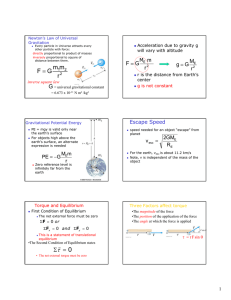Document 11085648
advertisement

IX.
NOISE IN ELECTRON DEVICES
A.
Dr. J. K. D. Verma
J. G. Ingersoll
Prof. J. B. Wiesner
Prof. R. B. Adler
Prof. H. A. Haus
LANGEVIN EQUATION FOR MICROWAVE FERRITE WITH THERMAL NOISE
The Langevin equation for a ferrite at thermodynamic equilibrium is presented. The
nature of the statistical "driving term" in this equation is such that it seems reasonable
to retain it unchanged, even in the presence of the pumping excitation which would be
used in a parametric ferrite amplifier.
The equation of a ferrite with loss (1), with the use of the Landau-Lifshitz representation of the loss, is
dM
ay
(1)
H)
MI M X (MX
I-y (Mx H)
dt
dt
Now suppose that the ferrite is exposed to a time-independent magnetic field for producing the saturation magnetization M o
The thermal agitation in the ferrite causes a
.
deviation of the magnetization vector M from alignment with M .
This fluctuation can
be taken into account by supplementing Eq. 1 with a random torque T (in units of coul/m)
dM
dt
t
lay•
YI(IX H) - -
IMI
M X (MX H)+T
(2)
Denote by T(r,w) the complex Fourier amplitude of frequency w at the point r.
The
torque at the point r'
is denoted by T(r',0). Then, we can show that the correct equilibrium fluctuations of the magnetization vector will be produced if the mean-square
fluctuations of the three Cartesian torque components are
Tx(7,w) Tx( ',w)
x
x
= T (F, w) T y(',
y
y
w)
=
= 41ayM kTAf 6(i -
T (r,
z
) T* (Tý' w)
z
')
and mutually perpendicular torque components are uncorrelated.
(3)
Here, 5(r -
T') is a
delta function, indicating that the torques in adjacent volume elements are uncorrelated.
It is noteworthy that the spectrum of the torque distribution indicated in Eq. 3 is
uniform.
Accordingly, the fluctuations of the torque are extremely rapid compared with
any frequency for which Eq. 1 applies.
* This research was supported in part by Purchase Order
DDL-BZZZ with Lincoln
Laboratory, which is supported by the Department of the Army, the Department of the
Navy, and the Department of the Air Force under Contract AF19(122)-458 with M.I.T.
141
(IX.
NOISE IN ELECTRON DEVICES)
The proof of Eq. 3 is accomplished by reduction of Eq. 2 to small-signal form.
For
the small-signal complex vector ml of the magnetization we obtain the relation
jojom = jJ4oX •h + JM
(4)
where h is the small-signal complex magnetic field vector, JM is the magnetic noise
current density with a Fourier amplitude that is linearly related to T(r,w).
Then, we
make use of the fact that, at equilibrium, the magnetic noise current density of a medium
characterized by an equation in the form of Eq. 4 must satisfy the relation (see Quarterly
Progress Report, July 15,
1957, p. 113, cf. Eq. 6, which was developed for an isotropic
medium)
JM(r, ) JM(r', w)
=
Zjw4o(X - X ) kTAf 6(r - r')
(5)
in which the dagger indicates the complex-conjugate transpose of the tensor X. By comparing the explicit expression for JM(r,w), as obtained from Eq. 2, with Eq. 4 we find
that the mean-square fluctuations of the torque components are perpendicular to the
saturation magnetization M o .
The component of T parallel to M o does not affect the
small-signal equilibrium fluctuations of M, and therefore cannot be obtained from such
considerations.
However, by symmetry, it is reasonable to postulate a component of the
torque in the direction of M o that is equal to the component perpendicular to M o . The
resulting self-fluctuations and cross fluctuations of T(r,w), in Eq. 3, are more easily
generalized to parametrically excited ferrites.
We can develop a theory of noise in parametric ferrite amplifiers with the assumption
that the equilibrium distribution of the torque, in Eq. 3, is unaffected by the application
of the pump.
This is a reasonable assumption in view of the statistical independence
of the equilibrium torque at successive time intervals as indicated by its uniform frequency spectrum, and its statistical independence in two adjacent volume elements as
indicated by the delta function in Eq. 3.
H. A. Haus
References
1. N. Bloembergen, Magnetic resonance in ferrites, Proc. IRE 44, 1259-1269 (1956).
142





